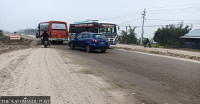National
Disease, hunger and chronic poverty kill people in Humla
Humla, once the crown of the ancient caravan trade route, today has the worst human development index in the country. Its people are deprived of the most basic of necessities, such as clean drinking water, nutritious food, health services, basic education, and sanitation. And the people’s miseries, experts say, were not created overnight: they are a result of continuous neglect by incumbent and past governments.
Arjun Poudel
Humla, once the crown of the ancient caravan trade route, today has the worst human development index in the country. Its people are deprived of the most basic of necessities, such as clean drinking water, nutritious food, health services, basic education, and sanitation. And the people’s miseries, experts say, were not created overnight: they are a result of continuous neglect by incumbent and past governments.
“Only those with power or those who can influence others in power have access to resources. The people in Humla and other districts in the midwest and far-west region of Nepal face the brunt of this unequal distribution of resources,” said Dr Sharad Onta, assistant dean at Institute of Medicine. “So much so that people there are dying from easily treatable and preventable diseases, such as flu, asthma and diarrhoea.”
Last month, 10 people, including two children, died and over 300 villagers were infected due to a flu-like illness in a span of two weeks. According to officials at the Ministry of Health and Population, those who died were also found to be suffering from chronic obstructive pulmonary diseases (COPD), while the children were malnourished.
“Flu and asthma would not kill children and middle-aged people with COPD in Kathmandu or other parts of the country,” said Dr KN Poudel, a consultant doctor at Provincial Hospital, Surkhet.
Poudel, one of the four doctors deployed by the government to contain the situation, said the living conditions of the people in the remote Tajakot rural municipality has shocked him. “Malnutrition is rampant in children and pregnant women. The people in Humla villages are deprived of basic health care services,” the doctor, who returned to Surkhet after his first visit to the remote village, told the Post. “The nearest hospital is three days away and it can cost villagers Rs60,000 to Rs100,000 just to reach.”
According to Nepal Demographic Health Survey 2016, the under-five mortality rate of Karnali region is 58 per 1,000 children, and 55 percent of the children suffer from stunting, which is double the national average. Both children and women in the region also suffer from anaemia, a blood condition that develops when blood lacks enough healthy red bloods cells that binds oxygen. Some 48 percent children and 35 percent women have anaemia.
The region is also the poorest and most food insecure. Compared to the national average of 15 percent, there is 40 percent food insecurity in the Karnali region and doctors say malnutrition increases pregnancy complications and maternal and neonatal deaths and also the likelihood of low birth weight.
“One can’t find fruits and vegetables here, and it is impossible to supply as it takes over three days just to reach here and everything will rot by then,” said Dr Manoj Timilsina, another doctor deployed to Humla.
In the last fiscal year, 19 women died during childbirth and some 187 neonatal deaths and 403 stillbirths were recorded in the region. According to the latest human development index report, Humla is among the most deprived districts in terms of health, education and sanitation. Life expectancy in the region is only 58 years compared to a national average of 70 plus.
Humla is also one of the most deprived districts when it comes to accessing drinking water and sanitation. According to Timilsina, the entire area reels under acute water scarcity and flies could be found everywhere, increasing infections risks for doctors themselves.
“The conditions in Humla are so terrible that if people aged 50 fall sick, they are not taken to the hospital,” said Timilsina. “The family and relatives wait for their death."




 18.12°C Kathmandu
18.12°C Kathmandu















